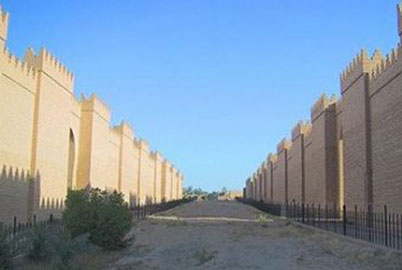
UNESCO’s “Final Report on Damage Assessment in Babylon” was presented at a press conference in Paris today. Produced by the Sub-Committee on Babylon of UNESCO’s International Coordination Committee for Safeguarding of the Cultural Heritage of Iraq (ICC Iraq), it provides an exhaustive technical evaluation of present conditions at the renowned archaeological site. It compiles several national reports and includes the findings of the two most recent inspections by members of the Committee in 2008 and 2009. A list of recommendations for the future protection, restoration and management concludes the Report.
The archaeological site of Babylon was used as a base by coalition forces from 2003 to 2004, an encroachment a 2005 British Museum report called “tantamount to establishing a military camp around the Great Pyramid in Egypt or around Stonehenge in Britain.” Substantial damage was caused to the archaeological city, the report notes, by “digging, cutting, scraping and levelling”; key structures harmed “include the Ishtar Gate and the Processional Way”. The Final Report describes deterioration that occurred not only during this period, but also before and after.
“In view of Babylon’s historical and archaeological significance, recent allegations of damage to the site during its military use were particularly serious,” explains Mohamed Djelid, director of UNESCO’s Office for Iraq. “The report is key because it establishes a description of damages on which there is international agreement. Without pointing fingers, we now have a clear picture of the situation. It provides the starting-point for the major challenge of restoration and conservation.”
Babylon, capital city of two famous kings of antiquity - Hammurabi (1792-1750 BC) who introduced one of the world’s first law codes, and Nebuchadnezzar (604-562 BC) who built the Hanging Gardens of Babylon, one of the Seven Wonders of the World – is located 90 km south of Baghdad. The Inner City covers an area of 2.99 km2 and the outer walls surrounding the city east and west of the Euphrates enclose an area of 9.56 km2. Listed as an archaeological site since 1935, it has been partially excavated over the last century, but much of ancient Babylon remains to be discovered.
As the Final Report recapitulates, the Iraqi government’s ambitious 1978-87 Archaeological Restoration of Babylon Project rebuilt ancient buildings, introduced modern facilities and undertook major landscaping, in part for a new palace for Saddam Husssein, “to the great detriment of the site”. Then the archaeological city was plundered during the war in 2003. Contents of the Nebuchadnezzar and Hammurabi museums and of the Babylon Library and Archive were stolen and destroyed. Finally, after serving as a camp for the Multi-National Force-Iraq between April 2003 and December 2004, Babylon was handed back to the Iraqi State Board of Antiquities and Heritage (SBAH).
Various experts and institutions carried out the assessments included in the Final Report. Those cited are the Report by SBAH; the Report for the international audit commission, prepared by Polish archaeologists attached to the MNF-I Iraq; the Visit and Report by Dr John Curtis of the British Museum; the Assessment of Damage to Babylon based on Digital Globe Satellite Imagery by Dr. Elizabeth Stone, Stony Brook University; the Report by Professor Roberto Parapetti for the Centro Ricerche Archeologiche e Scavi di Torino; and the Report by Professor John Russell for the US Department of State. Latest findings from the visits of Dr Russell in July 2008 and Dr Curtis in February 2009, undertaken on behalf of ICC-Iraq, have been incorporated.
It is “gratifying”, the latest mission noted, that “there are no signs of malicious or accidental damage to the site of Babylon since December 2004. The major problems now arise from neglect and lack of maintenance. The restored buildings at Babylon are all in poor condition, particularly the Ninmakh Temple, the Nabu-sha-Harre Temple, the Ishtar Temple, the Babylonian Houses and the Southern Palace of Nebuchadnezzar, and they need urgent attention.”
The Final Report concludes with recommendations from ICC-Iraq: The provisions of the Iraqi Antiquity laws should be observed on the site of Babylon; the SBAH should investigate and report on the archaeological implications for the disturbed areas; based on the results, the SBAH should develop and implement a site management conservation plan for Babylon in close cooperation with the UNESCO ICC – Babylon Sub-Committee; emergency interventions should be undertaken by SBAH and reported upon, particularly repair of the Ninmakh Temple, Nabu-sha-Hare, Ishtar Temple and the Inner City Wall; and the SBAH should consider the partial reopening of the site. Finally, all activities should be undertaken with a view to the nomination of Babylon for inscription on the UNESCO World Heritage List.













Stay In Touch
Follow us on social networks
Subscribe to weekly newsletter